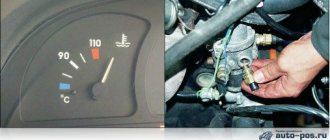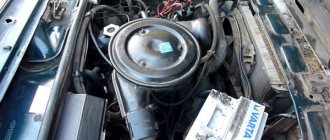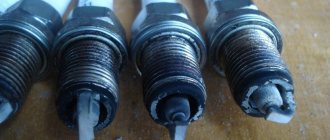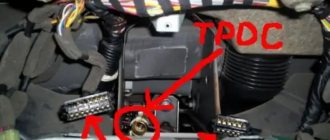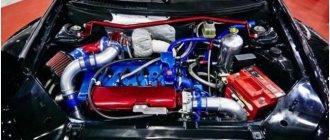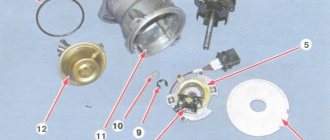Causes of overheating
All possible causes of overheating of the power unit of a VAZ 2109 car, as well as other cars, can be divided into two categories:
- External reasons;
- Internal reasons.
As you know, domestic nines are equipped with injectors and carburetors. Therefore, we will get acquainted with all the likely situations that can lead to overheating of one or another type of engine.
External
Let's start with the external reasons for the increase in engine temperature.
Causes
Features of the situation
Low coolant level
Quite often the engine overheats due to a low level of coolant in the expansion tank. It is not always possible to immediately detect a leak in the system. Antifreeze requires a very small hole in order for it to completely drain out of the tank over several tens of kilometers. The most dangerous leak is coolant entering the combustion chamber or oil, which leads to water hammer
If your engine begins to overheat, pay attention to the condition of the thermostat. This unit controls the movement of coolant through a large or small circuit
If the thermostat breaks down, the coolant stops moving in a large or small circle. In the first case, the engine will have difficulty warming up to operating temperature in winter, and in the second, the engine will constantly overheat
Radiator clogged, ineffective cooling
If almost the main component of the cooling system, that is, the radiator, becomes dirty, overheating will not be avoided. If there is dirt on the radiator fins or its “honeycombs,” heat transfer is significantly reduced
Plus, pay attention to the performance of the fan. It may not work due to belt tension, a broken temperature sensor, or a failed fan motor.
Long-term operation in unacceptable conditions
Often the cause of increased engine temperature is the driver himself, who overestimates the capabilities of his car and operates it in conditions that are contraindicated for it. These include prolonged idling, improper slipping, increased speed - all these situations negatively affect the condition of the engine, since the cooling system does not have time to perform its functions.
Engine operation under detonation conditions
If the driver ignores the appearance of detonation in the cylinders, the engine cooling system will not be able to cope with the load. Add to this the hot weather, and then you won’t envy the engine
Exhaust valve burnout
If the exhaust valve fails, the gases heated to an impressive temperature will overheat the engine. The situation can only be corrected by repairing the power unit
Water pump problems
If the water pump fails or stops working properly, coolant will not be able to circulate through the system. Pump failure may be due to tension in the drive belt, defective pump blades, or breakdown of the pump itself.
Internal reasons
There are several reasons that contribute to internal engine overheating.
Causes
Peculiarities
Accumulation of deposits inside the combustion chamber
This is a typical problem for old VAZ 2109 carburetor and injection engines, which have driven more than 200-300 thousand kilometers. Excess oil forms in the combustion chamber. Oil burns poorly, causing plaque to accumulate on the walls. This leads to overheating, which the temperature sensor cannot report. The malfunction can be determined by the bluish smoke protruding from the exhaust pipe. Or the impaired performance of the motor will indicate this
Plaque in the cooling radiator
The mistake of many owners of domestic cars is that they consider it sufficient to pour plain water into the cooling system, replacing the not-so-expensive antifreeze with it. But due to contamination of the water or the use of low-quality coolant, plaque forms on the walls and tubes, preventing normal cooling of the engine. It is not uncommon that the channels are simply blocked by plaque, which leads to impaired access of coolant to them. Overheating is only a matter of time in such a situation
Additives in oil
We don’t know how to explain the desire to add all kinds of additives to the oil. But if you do this and don’t know why these additives are actually needed, an impressive coating will form on the cylinder walls, due to which a violation of the efficiency of the cooling system cannot be avoided
It is not enough just to know about the probable causes of overheating of your carburetor or injector on a VAZ 2109. Be sure to familiarize yourself with the consequences, as well as your actions in a given situation.
The engine of a VAZ 2108, 2109, 21099 car overheats
The reasons for overheating of the carburetor engine of VAZ 2108, 2109, 21099 cars and their modifications are malfunctions of the cooling system, ignition system, and the engine itself.
Failure to pay attention to this problem in a timely manner leads to sedimentation of the piston rings, damage to the head gasket, deformation of the cylinder head, that is, to such consequences after which a major engine overhaul is inevitable. Low level of coolant (antifreeze, antifreeze) in the expansion tank
Add coolant to the expansion tank. On a cold engine, the level should be between the MIN and MAX marks. Check the cooling system elements for coolant leaks.
The radiator fan switch sensor, the fan electric motor, or their electrical circuit is faulty
Breakdowns
The most popular and common breakdowns of DTOZH include:
- Lack of contact with the sensor;
- Break of contact, insulation disappears;
- The device stops working;
- The fan does not turn on when required.
It is also important to examine the signs of trouble. These include:
- The engine has not yet warmed up, but the fan is already starting to work;
- The engine has warmed up, but still does not work properly;
- Fuel consumption has increased significantly.
One of the common mistakes made by beginners is that they often confuse the coolant temperature indicator sensor with the coolant temperature indicator.
https://youtube.com/watch?v=IWO7xJG5zGY
Procedure for removing DTOZH
It should be noted that the operating temperature of the 8 valve VAZ 2114 engine is 80-90 degrees Celsius. But these are optimal indicators that may vary depending on various factors. If the engine overheats or heats up too quickly on a VAZ 2114, this cannot be ignored.
Twisting
You understand perfectly well that the coolant is called that for a reason. And if antifreeze boils in the expansion tank of a VAZ 2114, can this be considered normal? Not at all. It is not uncommon that the problem lies precisely in a faulty DVT.
To replace it, you need to perform several sequential steps.
- Drain the coolant. For this:
- Wait until the engine cools down if you have just driven into the garage;
- Arm yourself with ring wrenches for 17, 13 and 8;
- Take a container into which the coolant will be drained;
- Remove the engine protection, disconnect the radiator fasteners;
- Turn on the stove to maximum mode and open the heater tap along with the expansion tank cap;
- Place a container under the radiator and very carefully begin to unscrew the drain plug. High pressure releases antifreeze from the expansion tank of the VAZ 2114, so you need to act slowly;
- Over the course of 10 minutes, the liquid will gradually drain;
- At this time, go to the engine, place the same container under it and unscrew the plug from the cylinder block, which is located directly under the ignition module;
- You will have to wait about 10 more minutes for the liquid to drain out.
Now removes the old coolant temperature sensor:
Find it on your car; Look at the body, pay attention to the markings on one side of the hexagon. Remember the position so that when reassembling everything, do it the same way; The meter is dismantled using a 21 key; A new meter is being installed. We install a new device. For this:
We purchase a new TOZh sensor; Using the same 21 key, we mount it in place of the old one; We take into account the previously remembered markings and install the new sensor in a similar position; We apply a little heat sealant to the threads, which will ensure a high-quality connection; Coolant is refilled into the heating system and cylinder block. Just use a new one, even if the old one is in good condition. Look at the coolant level sensor on the VAZ 2114 to make sure the tank is full.
If after these manipulations the DTOZH still does not work, pay attention to several points:
- You may have screwed the new sensor into its seat poorly;
- It is possible that you forgot to fill the coolant;
- A leak of cooling liquid formed in the system, the generator was splashed with it;
- The new sensor could be defective. In this case, it is recommended to always leave the purchase receipt until you are sure that the sensor is working properly. Unfortunately, it is impossible to verify this on site.
Unfortunately, replacing the sensor yourself does not always give the result you expected. Therefore, the car may continue to act up. Everything that you could do has already been done, so we recommend that you contact a good car service center, where they will carry out diagnostics and be able to determine what really happened to your car.
Not all issues can be resolved on your own, no matter how experienced an auto mechanic you are. Sometimes you have to go to a service station. But here, too, you must be sure that the specialists are competent, their equipment is in good working order, and they have enough experience in order to efficiently solve the problem that you and your car have. Make good friends at car repair shops. Even if you visit them once a year.
Engine overheating due to incorrect adjustment
The engine can overheat due to very late ignition, a very lean mixture supplied by the carburetor, a broken pump belt, a tightened alternator belt, a clogged radiator, or a broken pump impeller, but this is a rare case.
You can check the pump this way, the easiest way is to turn on the heater; if hot air blows for several minutes, the pump works, but this is provided that the coolant is normal. But the stove may stop heating if the gasket under the head has burned out and gases enter the cooling system.
If the engine overheats in traffic jams in hot weather, but when driving on the highway the temperature is normal, most likely the problem is in the radiator.
At this engine temperature, the radiator should not be warm but very hot. Dimmich, check if the thermostat opens completely, if so, flush the radiator, there is a thread on flushing on the forum.
If the panel is high, then there is a mixture of cold air from the street. If the heater radiator is clogged, then the air will also flow cold. I install caps from 1.5 liter plastic bottles with 4-5 holes in a small pipe from the thermostat to the block. In general, there is a small circulation in a small circle. I have a VAZ-2109 1.5 also likes to heat up
Engine warm-up temperature and time
If we talk about the warm season, then a couple of minutes of idling will be enough for a fuel-injected car or diesel engine. Carburetor engines need to be warmed up for 7-8 minutes. Then you can start driving in lower gears and low revs (about 2000 for a gasoline car and 1200 for a diesel vehicle). In winter the situation changes.
Gasoline engines
If your engine has a carburetor, then it needs to be warmed up for at least 15 minutes. In severe frost this time may be increased. The main task is to warm up until the engine runs stably when you press the gas pedal and increase the fuel supply. Carburetor engines must be heated to 40 degrees or more before driving, guided by a special mark on the temperature scale.
The minimum warm-up time for an injection gasoline engine can be considered to be about 5 minutes. During warm-up, you need to monitor the tachometer, since after starting a cold internal combustion engine, the idle speed is usually overestimated by the ECU. As the temperature rises, the tachometer needle will drop to 750-900 rpm, after which you can start driving.
Warming up the engine with HBO
The presence of gas equipment up to the 4th generation, where the choice of fuel type is carried out manually, obliges drivers to adhere to certain rules. It is recommended to start the engine and its subsequent warming up strictly on gasoline.
In winter, it is advisable to use gasoline until the internal combustion engine reaches operating temperatures, after which it switches to gas. If there are no severe frosts, then the minimum temperature for warming up the engine before switching to gas is about 50 degrees Celsius. Ignoring these rules can quickly damage the LPG gearbox, and running a cold engine on gas has a negative impact on the service life of the power plant.
How to warm up a diesel
Winter warming up of a diesel engine at idle for 5-10 minutes is also necessary, although the temperature of engines of this type rises more slowly compared to their gasoline counterparts.
Please note that you do not need to wait for the temperature gauge to start rising before starting your trip. After warming up at idle, a diesel car is usually warmed up while driving.
In this case, the diesel engine starts using the remaining diesel fuel, while fresh fuel is not supplied due to clogging of the fuel filter with paraffin, etc. Taking into account this feature, the right solution in winter would be to warm up the diesel engine for about 10 minutes, which will ensure normal fluidity and a stable supply of diesel fuel to the engine without the risk of stalling at a busy intersection.
Why is it better to warm up the engine before driving: lubrication, fuel, wear of cold parts. How to properly warm up a diesel engine in winter.
How to add oil to the engine correctly. Topping up “on a cold one”, adding lubricant to a hot engine. What oil can be used for topping up, useful tips.
The engine warms up slowly at idle or while driving: why does this happen? Possible malfunctions of the cooling system, other reasons.
To warm up or not to warm up the engine in winter before driving. Why the engine should be warmed up, how to properly warm up the engine before driving and while driving.
The engine temperature does not rise, the internal combustion engine temperature needle drops while driving. Why does the temperature drop after turning on the stove? Diagnostics and repair, advice.
The main reasons why the engine starts to stall after warming up. Frequent problems of carburetor and injection engines, fault diagnosis.
Source
VAZ engine takes a long time to warm up
How long should it take for the VAZ engine to reach operating temperature? The question is very interesting, and if you read various forums, the answers will be very diverse. There are people who claim that their car warms up to operating temperature in literally 5 minutes at idle. There are also other cars that take much longer to warm up to 90 degrees - about half an hour. What determines the engine warm-up time?
- Stove operation. The stove greatly influences the increase in engine temperature. The operation of the stove is similar to the operation of the radiator of the cooling system in that it removes heat from the engine. But the radiator only works when the thermostat opens, and the coolant circulates through the heater constantly (in new VAZ models). In older models - if the stove tap is open. And if the airflow is at full power and the heater is fully open, then naturally part of the heat that could quickly raise the engine temperature goes to heating the cabin. Conclusion: if you want the car to warm up faster, you need to turn off the airflow. This is what happens in climate control in AUTO mode.
- Thermostat. Very often it is the thermostat that causes long warm-up times. A stuck thermostat is the reason why many cars take a long time to warm up.
- Antifreeze quality. Antifreezes vary in price, which means they vary in quality. Antifreeze with an expired expiration date and poor heat transfer has a bad effect on the warm-up speed.
- Efficiency of the pump (water pump). If there is insufficient circulation, heat will slowly spread through the engine cooling system. It is quite difficult to test the pump in terms of its performance. As an option, you can find a car the same as yours and press the upper radiator hose on a warm engine. At the same time, you will feel the circulation of antifreeze and you can compare it in yourself and in your twin car. However, this method is not very convenient, because... The thermostat may be open more in one car, less in another and it is difficult to make any call. But many adhere to the rule - change the pump every 100 thousand kilometers.
- A water lock in the system can also cause poor circulation and a long warm-up time for the engine.
- ECU settings. If for some reason such ECU settings as injection duration and ignition timing adjustment are lost or were initially incorrect, then this also affects the warm-up speed of the VAZ engine.
What to do first
In order not to get buried in the abundance of reasons, it is necessary to act from simple to complex. Leave the frightening thoughts of a broken cylinder head gasket and take a trifling attitude, as if the electric damper actuator has failed. Actually, that's where we'll start.
Check the operation of the climate control shutters
Turn the knob or rocker of the climate system and evaluate the temperature of the incoming air. For example, with “blue all the way” the air should be noticeably cold, and with the maximum red settings it should be warmer.
Immobilized valves will not be able to mix flows according to the specified °C value. Therefore, at any position of the regulator, air will blow at the same temperature. The dampers stop as a result of damaged fasteners or a failed servomotor.
Is the antifreeze level in the expansion tank stable?
Lift the hood, find the “extender” and the boundary marks on it. When cold, the antifreeze level should be between the MIN and MAX marks. If the tank is constantly emptying, look for leaks. You can look at where the coolant goes using the Lada Vesta as an example.
Heater radiators of some cars, for example Lada Kalina, are very sensitive to the amount of antifreeze in the expansion tank. At the slightest leak, the engine heats up, and the stove is cold or barely warm. And in general, when liquid flows out, air comes in and thus the system becomes airy.
Inspect the heater radiator for unobstructed circulation
Find two pipes going to the heater heat exchanger near the engine shield and touch them. The radiator assembly is embedded in a small circle in parallel, which means that the hoses should warm up immediately after starting the engine. It is better to carry out work when the engine is warmed up.
If one of the tubes is cold and the other is warm, the radiator is clogged or airy. First, rule out the presence of a dirt plug: pull off the outlet hose and evaluate the flow - practically nothing will flow out of a clogged radiator installation. Isn't that the point? Then feel free to expel the air.
How to remove an air lock without draining the coolant
It happens that if there is air in a small circuit, the temperature sensor on the dashboard behaves strangely: the needle sometimes jumps. For example, it was at 60°C and instantly became 90-100°C, then returned back. This is explained by the fact that the air heats up noticeably faster than the liquid and to higher temperatures. As a rule, the needle twitches when the system is seriously aired.
The fact is that a small traffic jam does not always go around the entire small circle. Air accumulates at the highest point of the circuit - the radiator of the car furnace, causing the circulation of coolant in it to slow down. At the same time, there are no sudden temperature changes in the motor jacket. Even without observing extraneous symptoms, assume that the engine is overheating and the cabin heater is blowing cold air due to air accumulation. Try to etch it out, because you don’t need to disassemble anything:
- Raise the front end on a lift or drive up a hill.
- Allow air to escape through the highest point in the system. Why unscrew the cap of the expansion tank if it is a circulation tank (there is no plug on the engine radiator), or the cover of the engine heat exchanger. On front-wheel drive Ladas, the highest point is the throttle heating hose, disconnect it.
- Warm up the engine to operating temperature at idle speed.
- Increase the speed to 2,500-2,700 units.
How to easily remove a dirt plug from a furnace heat exchanger
When one side of the heater radiator is cold and the other is hot + no antifreeze is coming out, feel free to flush the heater radiator installation. There is no need to remove anything except the pipes. The only equipment that will be useful is a submersible pump from a country well, a deep basin, long hoses and one of the means for flushing the car engine cooling system.
Find out where the heat exchanger has the inlet and outlet and start cleaning:
- Disconnect the standard tubes. When dismantling the pipes, 1-1.5 liters will drain. coolant. A 2-3 liter coolant canister is quite enough to replenish reserves. There is no need to drain all the antifreeze from the system.
- Connect the hoses leading to the pump and basin: supply to the radiator outlet, drain to the inlet.
- Fill the container with cleaning agent.
- Turn on the pump for 10-15 seconds.
- Reconnect the hoses: supply - to the inlet of the heat exchanger, drain - to the outlet.
- Turn on the pump for 15-20 minutes.
A few comments:
- The flushing composition will circulate in a circular manner: from the basin and back into it.
- A short supply of fluid in the opposite direction quickly flushes out the dirt plug at the radiator inlet.
- Check whether antifreeze flows from the radiator steam pipes into the tank (relevant for circulation “expanders”).
Possible problems with improper engine warming up
Driving in a cold car threatens the driver with many troubles.
Oil sensor failure
A pressing problem for car models in which the oil sensor is mounted in a plastic housing. Viscous cold oil can crush fragile material, as a result of which the driver receives a signal that there is a lack of lubricant in the sump. Sensors in a metal case do not suffer from such a malfunction.
Malfunction of hydraulic tensioners and hydraulic compensators
Both of these devices that operate using oil suffer. Hydraulic tensioners tension the chain, and hydraulic compensators select valve clearances. If you start driving in a cold car, these devices will operate with little efficiency. For example, the valves will start knocking until the lubricant warms up. If you practice this starting mode every day, hardening will form on the valve stems and repairs will be required.
Failure of compression and oil scraper rings
Driving with a cold engine always carries the risk of damaging the piston rings. As the cylinders cool, they contract, reducing the gap between the wall and the rings installed in the piston grooves. When the engine starts, the piston group begins to work with tension. Added to this is “oil starvation”, and increased wear of the cylinders occurs.
If overloaded, the ring may crack and begin to leave marks on the cylinder wall. Some of the burnt gases will break into the oil pan, quickly reducing the quality of the lubricant. Dirty oil that is not filtered on a cold engine also leads to premature wear of rings and cylinders.
Thus, starting on a cold car does not bode well. Therefore, it is better to spend a few minutes warming up the engine than to carry out expensive repairs later.
VAZ 2110 takes a long time to warm up, why does this happen?
Cars from domestic manufacturers have always had plenty of problems. Yes, in the early and mid-80s of the last century, the Russian automobile company AvtoVAZ made a splash with its technologically equipped and affordable copies - and nothing has changed since then. True, nothing has changed in the bad sense of the word.
The same technologies are used: low-power, albeit high-resource engines, primitive design and interior, low-quality interior materials, unpleasantly surprising safety test results.
In fact, the VAZ is only suitable as a means of transportation “from point A to point B”, because comfortable movements on it are completely excluded.
Long engine warm-up on a VAZ-2110 with 16 valves
The reason that the temperature of the internal combustion engine remains the same, despite a fairly large amount of time spent on warming up, in most cases lies in a malfunction of the thermostat. In such cases, one of its valves gets stuck due to a defect and does not change position even after the ignition is turned on. Thus, the circulation of the working cooling fluid will always occur in a large circle, preventing the engine from reaching the optimal operating temperature.
Now a little lifehack. Take the key (17 or 19) in your hands and knock on the thermostat, but not too hard (don’t break it). This often helps, but not for long. The best way to repair it is to replace it.
It may seem to some that this is not a problem at all, especially in the summer, since the lower the temperature of the internal combustion engine, the more the risk of overheating and failure is eliminated. However, precisely because the operating temperature range has not been reached, all propulsion systems do not operate efficiently enough.
Sharp acceleration in such cases is unacceptable - wear of parts at low temperatures increases many times over. In addition, the interior of the VAZ-2110, the thermal insulation of which deserves far from the most flattering words, needs to be thoroughly warmed up, especially when it comes to winter use.
And if the thermostat malfunctions, the air emanating from the dampers simply will not heat up, and passengers will have to put up with discomfort throughout the entire trip.
How to fix the problem
The logical solution to the problem, in this case, is to replace either the thermostat itself or the component thermoelement. Both options are quite cheap, since we are talking about a domestic manufacturer, there is no need to buy any analogues.
This procedure can easily be carried out independently, but if you do not know the technical component of the VAZ-2110, it is still better to contact specialists at service stations.
The most important thing is to first drain all the antifreeze in the system.
As a result of the replacement, the car’s instrument scale should show an engine temperature of at least 90 degrees after 20-30 minutes of warming up or 10-15 minutes of driving without prior waiting.
The thermostat scale must be monitored periodically, at least once every 15 minutes of travel.
A quick glance is enough to ensure that the engine temperature is within the required range, which will automatically indicate the integrity and suitability of the thermostat itself.
Long warm-up can also be a consequence of incorrectly selected antifreeze for the cooling system, but such cases, as practice shows, are rare.
A few more reasons why the engine takes a long time to warm up
In winter (from -10 and below), the car should warm up to operating temperature in about 10 minutes. But in my practice, I found that after 5 minutes of warming up + 5 km to work, the coolant temperature gauge showed 70-80 degrees. After that, I wondered what the problem was, why the engine took a long time to heat up, and finally solved this problem.
For what other reasons does the car take a long time to warm up to operating temperature?
- The reason for the early start of the radiator is incorrect ECU settings. Here it all depends on the settings of your firmware, but by installing the BC (on-board computer), you can adjust the temperature at which the fan turns on (not all BCs have this function). On a stock VAZ 2114 2113 2115 the fan should turn on at 105 degrees.
- A faulty thermostat can also be the cause of long warm-up (but we wrote about this above). It can constantly circulate coolant in a large circle, which is why the engine takes a long time to warm up. To check the thermostat, read the article: VAZ thermostat.
- Consequences of illiterate chip tuning. In principle, this and the second point can be linked together, because again, the reason lies with the ECU settings.
Why does the engine take a long time to warm up?
As you know, there are constant disputes among car enthusiasts regarding warming up the engine before driving, the operating temperature of the internal combustion engine and the speed at which it reaches the required heating. However, most motorists continue to warm up their engine every morning. Accordingly, from time to time with some regularity the question arises about why the engine takes a long time to warm up.
Engine modification and tuning
Tuning the VAZ 2115 engine is divided into two substages - mechanical modification and chip tuning. The first option involves boring the cylinder block and installing an engine kit. But, as practice shows, mechanical tuning of the VAZ 2115 ends with superficial modifications to the engine.
For example, by installing silicone pipes, as well as a “zero” resistance filter. Although there are motorists who go all the way and do a complete mechanical tuning of the engine.
Chip tuning of the VAZ 2115 is carried out according to the scheme. The car enthusiast chooses one of the options: increasing power, reducing consumption or balanced, and after that the auto electrician programs the electronic engine control unit to the desired result.
The development of modern technologies makes it possible to carry out such an operation independently, without trips to a car service center. It is worth remembering that one awkward movement can lead to the engine working incorrectly or not starting at all.
How to diagnose the cause of a drop in engine temperature
If while driving the sensor needle drops and stops responding for some time, then the problem is a malfunction of the sensor itself, and it will need to be replaced.
Movement is carried out at average speed (70 km/h), while maintaining a low engine temperature. In most cases, the problem is a stuck thermostat. When the heat-removing liquid is heated, the device switches to a large circulation circle and acts as a regulator. In winter, the liquid flows almost all the time along a small circuit without the participation of a radiator.
Natural airflow is sufficient to maintain the operating temperature of a running engine. But if the thermostat is stuck in the open position, heat removal will not be able to occur fully. The power plant simply will not be able to generate enough heat to heat the heat sink in the mode of a large circulation circuit. This will require replacing the thermostat.
Checking the operation of the temperature controller can be carried out without moving the car. On site you will need to start and warm up the car for 20-30 minutes. After these steps, open the hood of the car and try heating the pipes at the top and bottom of the radiator. One tube should be warm, the other cold. If the pipes are at the same temperature, then the thermostat has failed.
If a car engine takes a long time to warm up and the engine temperature does not rise, the reason is a malfunction of the device valve.
Causes of poor coolant circulation
According to the above diagram, the reason that the lower radiator pipe in the VAZ 2110, 2114, 2115 remains cold is the lack of fluid circulation in a large circle of the system. Note that the radiator is the main cooling element. Therefore, the upper pipe through which the liquid enters the heat exchanger will be hotter than the lower one, even if the liquid circulates correctly.
Possible causes of stagnation in the cooling system:
- radiator clogged;
- non-working thermostat;
- airlock;
- pump breakdown.
Any intervention in the engine cooling system requires subsequent flushing of the ODS and replacement of the coolant. Poor quality coolant cannot cope with cooling the engine and can cause a blockage in the system.
Does the engine on the VAZ 2109 injector get very hot? The problem is solvable
Download PDF
Unfortunately, the situation when the engine on a VAZ 2109 injector gets hot is not uncommon and is well known to the owners of this car.
Problems with the temperature conditions of engines on VAZ-designed cars are common and do not surprise anyone. Sometimes it even seems that the design of the engine cooling system on VAZs is someone’s bad joke, aimed at testing the patience of car enthusiasts. When the engine on a VAZ 2109 injector heats up, this can be immediately determined by the sensor indicator on the dashboard, but what’s even worse, by the white steam that comes from under the hood.
The nature of engine overheating
There are a huge number of these same reasons, the nature of which is significantly different: for some, poor engine quality leads to overheating, for others there are malfunctions in the cooling system. However, the essence of the problem arises not only in faulty parts and systems of the car. In order to verify the problem, you need to familiarize yourself with the following manifestations:
To determine how hot the engine is, you need to measure its temperature. The main operating temperature range of the engine will be 85-95 degrees Celsius. Temperatures up to 105 degrees are accepted as an acceptable value, but with prolonged operation at this temperature, engine malfunctions soon appear. If the engine temperature is more than 105 degrees Celsius, the following measures must be taken based on the reasons given below.
This issue becomes especially relevant in the summer heat, when thirty-degree heat negatively affects the engine. Based on this, we can conclude that the reasons when it heats up are not only engine malfunctions, but also high temperature conditions
However, when considering this problem, you should pay attention to the purpose and condition of the following parts:
Thermostat
The operating principle of a normal cooling system is based on the circulation of coolant around a small circle of the cylinder, affecting the cylinder head and block. When the parts heat up, the thermostat valve begins to gradually open, which leads to the return of temperature to the system. In other words, the heated liquid goes through a second cycle, but does not bring any benefit. When 95-98 degrees Celsius is reached, the thermostat cover opens completely and the liquid begins to circulate in a large circle, cooling the entire engine and preventing it from overheating.
If a part malfunctions, the thermostat valve does not open completely, allowing antifreeze to partially pass through. In the worst case, the liquid that is driven through the internal circuit of the engine begins to boil. And the combustion temperature, in turn, reaches a record 2500 degrees.
To prevent disastrous consequences, it is necessary to regularly check the condition of the thermostat:
- it is necessary to warm up the car to operating temperature,
- check the radiator inlet and outlet hoses, both should be hot if the thermostat is working correctly,
- If, when the engine overheats, one hose remains cold, then the way out of the situation will be to completely replace the thermostat.
Electric fan
Problems with the cooling fan can also negatively affect engine temperature. The fan is triggered by a signal from a temperature sensor installed on the radiator or on the cylinder head, depending on the modification of the car that connects the fan.
Therefore, the sensor may be the cause of the fan malfunction:
- if the connection is poor, the sensor stops transmitting signals to the part, as a result of which the fan simply will not start and the engine heats up,
- If a problem is noticed in the operation of the fan, you should not blame the part itself.
Cooling radiator
One of the most common reasons when the engine overheats is clogged radiator honeycombs, which prevent the passage of fresh air to the fluid and disrupt heat transfer. In this case, the fault lies with the owner of the car, who does not wash the car and its components, resulting in unfavorable ventilation blockages. Many drivers use cardboard sheets to quickly warm up the engine in winter: to do this, just install them on the radiator cap and the hot air always remains inside, preventing cold air from entering. However, with the onset of summer, they forget about their devices and continue to drive with cardboard on the radiator. You may even need to flush the radiator.
The engine temperature arrow does not rise, the engine temperature fluctuates, the engine cools down while driving
The time it takes for the engine to warm up to operating temperature may vary for each serviceable unit. This happens due to the fact that heating and its intensity depend on a number of conditions. The warm-up speed can be affected by the degree of engine boost, its type (gasoline/diesel), the general condition of the cooling system, the quality of the antifreeze or antifreeze poured in, the outside temperature, the degree of load while driving, the intensity of the heater in the cabin, and so on.
Let us add that many experts agree that different types of motor oils and their viscosity can also affect the overall heating of the engine, although only slightly. The operating temperature of the oil in a conventional engine is around 100-150 degrees, not exceeding the maximum threshold of about 200 degrees (all indicators are averaged). In parallel with this, the maximum oil temperature in the engine is determined by the flash point of the oil, its coking, etc.
It may seem that the temperature range will be the same for different oils, but this is not the case. Special additive packages that reduce friction losses and the base itself (synthetic, semi-synthetic) affect the degree of oil heating. In other words, low-viscosity oils cool rubbing couples better, but the lubricant itself heats up more. It turns out that with different engine oils, the temperature in the crankcase of the same internal combustion engine can differ by 5-7 degrees. If we take into account these features, then we can assume that with “liquid” synthetics, the engine will not only be easier to start in winter, but will also warm up faster.
So, let's return to the cooling system. A cold engine and a non-working heater in most cases are the consequences of thermostat malfunctions. If you notice that the power unit takes a very long time to heat up, the engine does not warm up to operating temperature, and the engine temperature gauge needle drops while driving, then you should start checking with this device.
The thermostat allows heated coolant to enter the radiator. This circulation through the radiator is called a large circle. The thermostat opens strictly at a certain temperature on different internal combustion engines (on average about 90 degrees Celsius), that is, up to the specified value, the liquid circulates only in a small circle. Problems begin when the thermostat stops opening or closing in a timely manner. If it does not open, then the engine overheats. If the thermostat is open all the time, the antifreeze will constantly circulate only in a large circle, and the engine will not warm up to operating temperature.
The thermostat jamming, both open and closed, occurs due to the accumulation of scale and other deposits in the cooling system. The reason is irregular changes of antifreeze or antifreeze every 3 or 4 years, mixing coolants with each other, using running water in the cooling system, ignoring the need to flush the system.
We also recommend reading the article on how to flush the cooling system yourself at home. From this article you will learn about various methods and means for flushing the engine cooling system with your own hands.
To check the thermostat, start the cold engine and let the unit idle for 5-10 minutes. Then you should feel with your hand the upper and lower hoses going to the radiator. If the thermostat is in good condition, then the pipes should not be heated. In other words, the coolant does not enter the large cooling system circuit until the liquid warms up to a temperature that is the opening temperature of the thermostat on a particular engine. In practice, this looks like this: the temperature arrow on the dashboard should rise, warm or even hot air should come out of the air deflectors, but the radiator pipes remain cold. Once the pointer reaches operating temperature, the thermostat should open. After this, the hot liquid will flow through the pipes in a large circle into the radiator, heating the indicated elements. It turns out that if the radiator and pipes immediately warm up after starting a cold engine, then the thermostat does not close the large circle, that is, its malfunction is obvious.
It is more difficult to determine a breakdown when the device opens or closes, but not completely. In such a situation, there may be partial overheating or insufficient heating of the motor. There are also cases when the thermostat does not jam constantly, but only periodically. In any case, the element must be removed, defective, repaired or completely replaced. On different engines, the location of the thermostat may differ. On some motors, access to the element can be very difficult. Usually the device is located in the place where the upper radiator hose approaches the engine. Less common are designs where the installation location is the area where the lower hose is supplied.
It should also be noted that to remove the thermostat, the liquid from the cooling system must be drained. We talked about how to do this in the article about flushing the cooling system. After removal, it is necessary to carefully inspect the thermostat, taking into account the features of its design. This is necessary for the correct selection of the appropriate analogue. On most engines, the thermostat opens a large circle, after which the coolant circulates through both the small and large circuits simultaneously. The engine is cooled due to less resistance to fluid flow in the large circuit compared to the small circuit. There are also thermostats that, when activated, open a channel in their housing, while simultaneously closing the channel in the engine block. This design allows the small circle to be closed, forcing the working fluid to circulate only along the large circuit through the radiator.
As for the selection of the thermostat itself, the following basic parameters should be taken into account when choosing it:
- physical size;
- response temperature;
- manufacturer;
Car manufacturers use thermostats from well-known companies, so there should be no problems with selecting a device. It should also be taken into account that very often thermostats of a particular brand can be interchangeable. For example, on GM cars, thermostats for one model can be successfully installed on another. As for the response temperature, it is usually stamped on the device body. It is advisable to install a new element with a similar characteristic so that the thermostat does not turn out to be too “cold” or “hot” on a particular engine.
